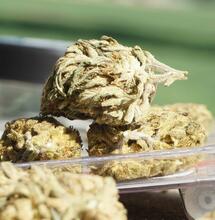Psicodelicia®

Your inspiration will be awoken
Your inspiration will be awoken
A nice lady from roots to terminal buds, a rapid growth, a great bloom, an intense aroma and a highly cerebral effect are all good reasons to include this plant among your favourites.
Psicodelicia® (or strain SWS07), of the Sweet Seeds seed bank, is one of the most complete plants ever created. Genetically it is a fast-flowering Sativa which combines the growing characteristics of medium-sized Indicas with a small inter-knot distance and a high yield – characterised by a large quantity of resin, but also the effect of Sativas, i.e. exciting and cerebrally active, making it particularly appropriate for activities needing imagination and creativity.
It is a fast-flowering plant, considering its large Sativa component; with 30% of Indica and 70% of Sativa, it only takes 8-9 weeks to develop indoors, and is harvested between late August and mid-September outdoors, yielding up to 400-600 g/m2 indoors and 450-700 g per plant outdoors. Produced from a cutting sourced from the United States which was crossed with a Nepali plan, the resulting strain has a strong, spicy and intensely roasted flavour.
Although it is suitable for indoor and outdoor growing alike, the size and density of its buds makes it prone to moulding and, therefore, unsuitable for particularly wet environments.
Our growing experience
We bought our first packet of Psicodelicia® seeds several years ago. We germinated them and starting monitoring our crop. We observed its rooting and growing speed and were impressed by its enormous buds. Therefore we compared the results obtained in our harvest and decided to purchase several packets, especially for the purpose of selecting a mother. All the seeds that we found in packets resembled each other and produced unremarkable results However, we decided to pinpoint even the smallest differences in inter-knot distance, size, aroma, quantity and quality of the herb, in order to select the best specimen and use it as a mother, bringing to our garden vigorous cuttings that invariably made us happy at harvest time. Each cutting produced between 30 and 45 g of dry buds with short growing periods.
Psicodelicia specimens with the best characteristics were kept for several years and the output in indoor cultivation was remarkable, with huge buds and white resin coatings that only needed a strong control of ambient humidity, and special care when “miniature bananas” appeared at the end of flowering. In a batch of cuttings placed in the grow-room, we discovered the presence of red spider and opted for taking the cuttings outside – we therefore took Psicodelicia® to a safe garden. We took advantage of the situation to study results outdoors for the sake of future crops.
The spider mite epidemics was discovered in early June. The plague was treated for the first time indoors with Expelex, a powerful vegetable insecticide produced from dry chrysanthemum flowers (natural pyrethrins), combined with potassium soap. Two days after the application, plants were transplanted to an outdoor crop in order to prevent the plague from spreading to the remaining grow-rooms.
Our Psicodelicia® therefore found a new home, surrounded by cabbages, tomatoes and other fauna and flora, in a place where it will soon go unnoticed by those who today are condemning it and tomorrow they will not even know why they condemned it.
As the garden soil had been tilled in the previous years, in the beginning it gave us the comfort of knowing that it had been prepared with suitable drainage and a sufficient quantity of nutrients, for our plants to grow as much as potentially possible. We only prepared a ditch of around 50 litres for roots to spread up to the mother-soil; this hole was then filled with a mixture of Bio Terra Plus and a fourth part of earthworm compost.
After six days of applying Expelex for the first time, we sprayed again a second dose to make sure that the spider plague could be definitively treated. The problem was solved.
We irrigated the area with Biorhizotonic the first week and only then did we apply, on two occasions, BioCannaVega as growth booster, no other improvements were needed for the plants to reach two metres plus in height.
Our Psicodelicia® developed and soon the early pistils started to be visible, which suggested an early harvest that would avoid us the trouble of the first autumn rainfalls as much as possible. During flowering we added, to the weekly irrigation cycle, BioCanna Flores as a flower booster and Bio Boost as a fertiliser – to deliver to the plant all the nutrients it needed. The growth of pistils and buds was ongoing and soon big “menhirs” appeared. Pistils became dark and we started to count days for harvest.
In early September, before harvest, buds were already so big that we feared a possible fungal attack; however, a preventive treatment with products was no longer advisable, given the advanced blooming stage. On that occasion, the scarce rainfall became abundant and, as expected, mould appeared. We had to check each branch, almost on a daily basis, for signs of spore proliferation. The heavy rainfall resulted in a large number of buds, which had to be torn off, given the plague suffered by the plant.
Finally, although we lost a large quantity of buds for botrytis, we reaped 300 g of impressive, tasty buds. Indeed this is one of the most recommendable and productive plants to be grown in your garden.



